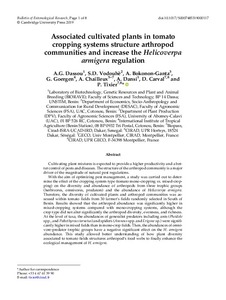| dc.contributor.author | Dassou, A.G. |
| dc.contributor.author | Vodouhè, S.D. |
| dc.contributor.author | Bokonon-Ganta, A. |
| dc.contributor.author | Goergen, G. |
| dc.contributor.author | Chailleux, A. |
| dc.contributor.author | Dansi, A. |
| dc.contributor.author | Carval, D. |
| dc.contributor.author | Tixier, P. |
| dc.date.accessioned | 2019-12-04T11:33:59Z |
| dc.date.available | 2019-12-04T11:33:59Z |
| dc.date.issued | 2019-04-10 |
| dc.identifier.citation | Dassou, A.G., Vodouhè, S.D., Bokonon-Ganta, A., Goergen, G., Chailleux, A., Dansi, A., ... & Tixier, P. (2019). Associated cultivated plants in tomato cropping systems structure arthropod communities and increase the Helicoverpa armigera regulation. Bulletin of Entomological Research, 1-8. |
| dc.identifier.issn | 0007-4853 |
| dc.identifier.uri | https://hdl.handle.net/20.500.12478/5861 |
| dc.description | Published online: 10 April 2019 |
| dc.description.abstract | Cultivating plant mixtures is expected to provide a higher productivity and a better control of pests and diseases. The structure of the arthropod community is a major driver of the magnitude of natural pest regulations.
With the aim of optimizing pest management, a study was carried out to determine the effect of the cropping system type (tomato mono-cropping vs. mixed-cropping) on the diversity and abundance of arthropods from three trophic groups (herbivores, omnivores, predators) and the abundance of Helicoverpa armigera. Therefore, the diversity of cultivated plants and arthropod communities was assessed within tomato fields from 30 farmer's fields randomly selected in South of Benin. Results showed that the arthropod abundance was significantly higher in mixed-cropping systems compared with mono-cropping systems, although the crop type did not alter significantly the arthropod diversity, evenness, and richness. At the level of taxa, the abundances of generalist predators including ants (Pheidole spp., and Paltothyreus tarsatus) and spiders (Araneus spp. and Erigone sp.) were significantly higher in mixed fields than in mono-crop fields. Then, the abundances of omnivore-predator trophic groups have a negative significant effect on the H. armigera abundance. This study allowed better understanding of how plant diversity associated to tomato fields structures arthropod's food webs to finally enhance the ecological management of H. armigera. |
| dc.description.sponsorship | Ecological Organic Agriculture |
| dc.format.extent | 1-8 |
| dc.language.iso | en |
| dc.rights | Copyrighted; all rights reserved |
| dc.subject | Ecological Control |
| dc.subject | Management |
| dc.subject | Food Webs |
| dc.subject | Helicoverpa Armigera |
| dc.subject | Ants |
| dc.title | Associated cultivated plants in tomato cropping systems structure arthropod communities and increase the Helicoverpa armigera regulation |
| dc.type | Journal Article |
| dc.description.version | Peer Review |
| cg.contributor.affiliation | Université Nationale des Sciences Technologies Ingénierie et Mathématiques |
| cg.contributor.affiliation | Université d'Abomey-Calavi |
| cg.contributor.affiliation | International Institute of Tropical Agriculture |
| cg.contributor.affiliation | Biopass, Cirad |
| cg.contributor.affiliation | University of Montpellier |
| cg.coverage.region | Africa |
| cg.coverage.region | West Africa |
| cg.coverage.country | Benin |
| cg.creator.identifier | Georg Goergen: 0000-0003-4496-0495 |
| cg.researchtheme | PLANT PRODUCTION & HEALTH |
| cg.isijournal | ISI Journal |
| cg.authorship.types | CGIAR and developing country institute |
| cg.iitasubject | Plant Health |
| cg.iitasubject | Plant Production |
| cg.journal | Bulletin of Entomological Research |
| cg.howpublished | Formally Published |
| cg.accessibilitystatus | Limited Access |
| local.dspaceid | 105626 |
| cg.targetaudience | Scientists |
| cg.identifier.doi | https://dx.doi.org/10.1017/S0007485319000117 |

